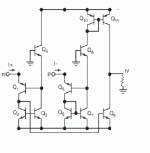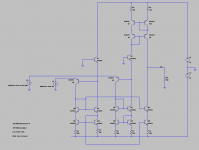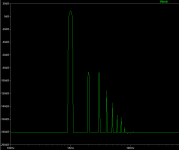I haven't tried that particular discrete circuit but in general discrete I/V circuits when well implemented do have purity of high frequencies that opamp-based circuits lack. I've found power supply impedance to be fairly important in getting the best dynamics, don't neglect giving your circuit a pair of low output impedance regulators.
I am planing to build a dac with no op-amp. It is based on PCM1794 + CDTA (Current differencing transconductance amplifier)-I/V + JFET-buffer.
Has anyone tried the CDTA circuit as I/V? good sound?
I think your circuit has been drawn incorrectly.
There are 2 BJTs with 'floating' bases.
T
I am planing to build a dac with no op-amp. It is based on PCM1794 + CDTA (Current differencing transconductance amplifier)-I/V + JFET-buffer.
Has anyone tried the CDTA circuit as I/V? good sound?
PS, it's worth putting this in Ltspice and see how it goes.
For the PCM1794, the DAC OP Z is pretty high, >= a few hundered k ohms,
so that is working for you, linearity wise. All the mirrors are working against
you, linearity wise and noise wise.
I've built a lot of grounded base design I-V's and when done right, they
sound really good. Devil is in the details.
TCD
...a pair of low output impedance regulators.
Turns out sometimes more that output impedance matters for sound quality. In some cases voltage regulator linearity or the lack thereof has audible effects. I haven't said much about that since it seems odd no one else figured it out, but recently I came across a document translated from Russian that mentions it in reference to AKM dacs. The document is in another thread here: FS: LynxAudio DAC D60
Turns out sometimes more that output impedance matters for sound quality. In some cases voltage regulator linearity or the lack thereof has audible effects. I haven't said much about that since it seems odd no one else figured it out...
I think the person who launched me into thinking in that direction was a member here, @peufeu. I raised the issue with the designer of the ADM7150 back in 2013, on this thread : https://www.diyaudio.com/forums/power-supplies/247643-modern-ultra-low-noise-ldo-adm7150-print.html
I think your circuit has been drawn incorrectly.
There are 2 BJTs with 'floating' bases.
T
Here is a LTspice sim, and I got a thd of -90db.
Attachments
Here is a LTspice sim, and I got a thd of -90db.
That's better.
I suggest doing open loop circuit sims at 10kHz or 20kHz. This will tell real
story of linearity when all the non linear capacitances come into play.
Also you will need to take care of OP offset.
Having said all of the above, this circuit will probably sound quite good, maybe
really good.
PS, you also should account for DAC OP Z. In the case of 1794 I use 200k or so.
Apparently it is even higher than that but 200k is safe. It will affect the distortion
to some degree.
TCD
Last edited:
Here is a LTspice sim, and I got a thd of -90db.
If the best SQ is your aim don't just sim for THD, also check PSRR by setting the supply to produce an AC voltage (with the source turned off) and sweep it across the frequency range monitoring the output.
<later> Since you provided the .asc I ran a quick check - the basic PSRR is fine, worst case about -67dB @20k on the +ve rail. -ve rail is better. Next step is to check how the circuit modulates its own supply rails and turns out that's not quite so good, there are very likely changes you can make to make the current draw more invariant of signal. But listen to it first before going on to that. I agree with @Terry, it'll probably sound very good.
Last edited:
Did anybody so far try the quite new OPA828 as I/V for PCM1704 or the like ?
It is marketed as an modern upgrade for OPA627/637 and 827 at a fraction of their costs.
The design has special speedup circuitry in the J-FET input stage to avoid slew rate limiting and as OPA627 also has a huge differential input voltage range (no antiparallel protection diodes in input, which TI calls "MUX friendly").
This is so far the lowest distortion J-FET OPamp I know of (Almost OPA1611 performance), but with the advantage of much better settling time and I/V friendly non saturating J-FET-input stage. The noise perfromance should be more than good enough for a PCM1704 or PCM179x.
It is marketed as an modern upgrade for OPA627/637 and 827 at a fraction of their costs.
The design has special speedup circuitry in the J-FET input stage to avoid slew rate limiting and as OPA627 also has a huge differential input voltage range (no antiparallel protection diodes in input, which TI calls "MUX friendly").
This is so far the lowest distortion J-FET OPamp I know of (Almost OPA1611 performance), but with the advantage of much better settling time and I/V friendly non saturating J-FET-input stage. The noise perfromance should be more than good enough for a PCM1704 or PCM179x.
^ thanks for pointing out this new part, Jon!
30 mA output, depending on the DAC, might run into some issues (which is crazy to think about, but that's how they're getting those crazy high SNR's nowadays), but I would imagine the OPA828 would work well on the front end of a composite with a fast CFA line driver if you're going for that crazy level of specmanship. JFET/CMOS front end, I think, helps with glitch energy (less likely to rectify RFI?), but I could be misremembering things. Done it a few times in my life.
There's also the OPA1656 which is acquitting itself nicely in the low distortion oscillator circuit. Fast, low noise CMOS front end, with a beefy output stage (and bias) seems like a ticket for some of these newer DACs as well.
30 mA output, depending on the DAC, might run into some issues (which is crazy to think about, but that's how they're getting those crazy high SNR's nowadays), but I would imagine the OPA828 would work well on the front end of a composite with a fast CFA line driver if you're going for that crazy level of specmanship. JFET/CMOS front end, I think, helps with glitch energy (less likely to rectify RFI?), but I could be misremembering things. Done it a few times in my life.
There's also the OPA1656 which is acquitting itself nicely in the low distortion oscillator circuit. Fast, low noise CMOS front end, with a beefy output stage (and bias) seems like a ticket for some of these newer DACs as well.
Last edited:
In fact, I had put in Yanasan's dual 4499 dac the OPA1656 as I/V converter and the OPA828 as diff/ SE summing. The result is quite spectacular.
I also use since it came out, the 828 as front end in Penasa' s Evolution amp, a composit power amp with dual 3886 buffer (current pump) in output.
Ciao, George
I also use since it came out, the 828 as front end in Penasa' s Evolution amp, a composit power amp with dual 3886 buffer (current pump) in output.
Ciao, George
Last edited:
In fact, I had put in Yanasan's dual 4499 dac the OPA1656 as I/V converter and the OPA828 as diff/ SE summing. The result is quite spectacular.
I also use since it came out, the 828 as front end in Penasa' s Evolution amp, a composit power amp with dual 3886 buffer (current pump) in output.
Ciao, George
Hey George, is it simple to compensate when used for the Penasa amp?
Did anybody so far try the quite new OPA828 as I/V for PCM1704 or the like ?
It is marketed as an modern upgrade for OPA627/637 and 827 at a fraction of their costs.
See also opa820/2810.
- Home
- Source & Line
- Digital Line Level
- Best opamp for I/V conversion? (DAC)


